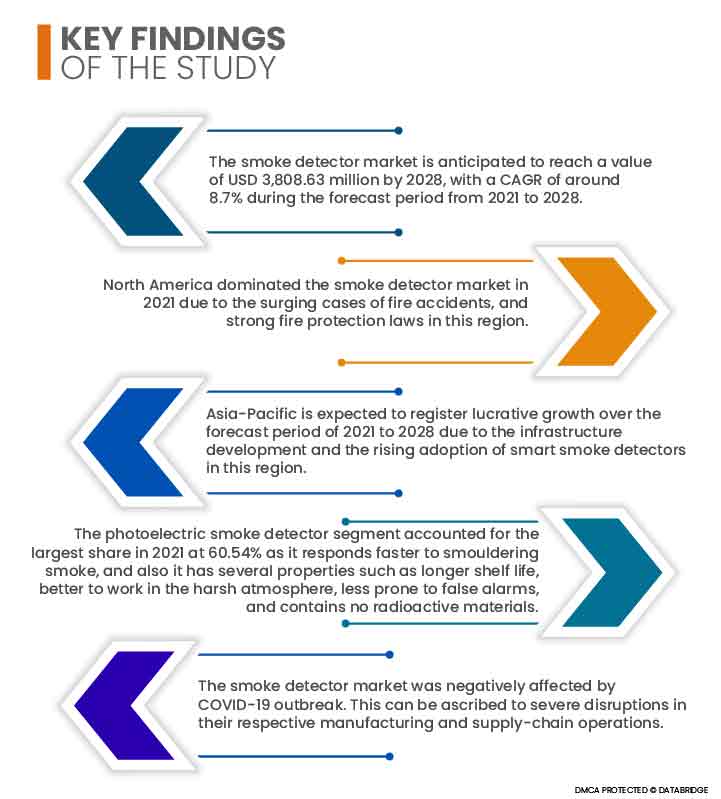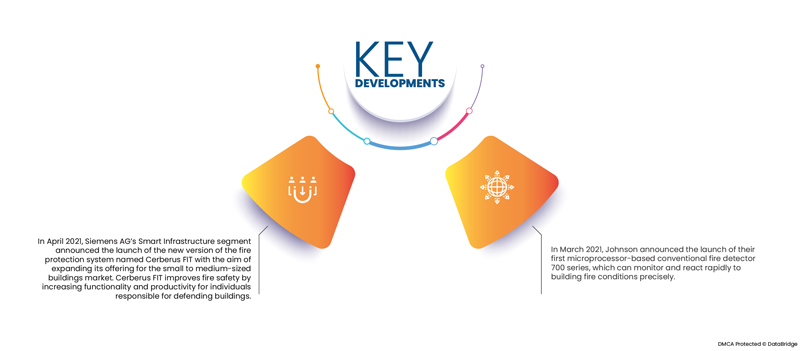연기 감지기는 화재의 중요한 지표인 연기의 존재를 감지하고 건물 거주자에게 경고 표시를 통해 알리는 전자식 화재 방지 장치입니다. 화재는 다양한 장소에서 언제든 발생할 수 있습니다. 연기 감지기는 인명과 재산을 보호하는 첫 번째이자 가장 중요한 단계입니다. 가장 일반적인 두 가지 유형의 연기 감지기는 광전식과 이온화식입니다. 광전식 연기 감지기는 적외선, 가시광선 또는 자외선을 방출하는 발광 다이오드와 챔버 내부에 위치한 감광 센서로 구성된 연기 감지기입니다. 소량의 방사성 물질을 사용하여 내부 센서 챔버의 공기를 이온화하는 연기 감지기를 이온화식 연기 감지기라고 합니다.
전체 보고서는 https://www.databridgemarketresearch.com/reports/global-smoke-detector-market 에서 확인하세요.
데이터 브리지 마켓 리서치(Data Bridge Market Research)는 연기 감지기 시장이 2021년부터 2028년까지 연평균 성장률(CAGR) 8.7%로 성장하여 2028년에는 38억 863만 달러(USD)에 이를 것으로 분석했습니다. 화재 사고로 인한 안전 우려 증가와 스마트 홈 및 빌딩 트렌드 발전이 시장 성장을 견인하는 주요 요인입니다. 시장 성장을 촉진하는 요인으로는 연기 감지기에 사물 인터넷(IoT) 기술이 도입되는 추세와 건설 산업에 대한 투자 증가 등이 있습니다.

- 연기 감지기 시장 규모는 2028년까지 38억 863만 달러에 이를 것으로 예상되며, 2021년부터 2028년까지 예측 기간 동안 약 8.7%의 CAGR이 성장할 것으로 전망됩니다.
- 북미는 2021년에 화재 사고가 급증하고 이 지역의 강력한 방화 법률로 인해 연기 감지기 시장을 장악했습니다.
- 아시아 태평양 지역은 인프라 개발과 스마트 연기 감지기 도입 증가로 인해 2021년부터 2028년까지의 예측 기간 동안 수익성 있는 성장을 기록할 것으로 예상됩니다.
- 광전식 연기 감지기 부문은 2021년에 60.54%로 가장 큰 점유율을 차지했는데, 그 이유는 연기에 더 빨리 반응하고, 보관 수명이 길고, 혹독한 환경에서도 잘 작동하며, 오경보가 적고, 방사성 물질이 포함되어 있지 않다는 등의 여러 가지 특성을 가지고 있기 때문입니다.
- 연기 감지기 시장은 COVID-19 발생으로 부정적인 영향을 받았습니다. 이는 각 업체의 제조 및 공급망 운영에 심각한 차질이 발생한 데 기인합니다.
상업 및 주거 지역에서 우발적 화재가 점점 더 빈번해짐에 따라 예측 기간 동안 시장 성장률이 높아질 것으로 예상됩니다.
상업 및 주거 환경에서 우발적인 화재 발생 빈도가 증가함에 따라 연기 감지 장비 시장이 크게 성장할 것으로 예상됩니다. 주거 및 상업 시설은 소규모 화재일지라도 화재에 더욱 취약합니다. 이러한 이유로 연기 및 화재 감지 장치는 건설 업계에서 필수적인 안전 장비로 자리매김할 것으로 예상됩니다. 현대의 상업 및 주거 인프라에서는 다층 구조의 소형 구조물이 흔하기 때문에 연기 및 화재 방지 장비 설치가 필수적입니다. 인프라 산업의 안전 요건 강화는 수요를 더욱 증가시킬 것으로 예상됩니다.
보고서 범위 및 시장 세분화
보고서 메트릭
|
세부
|
예측 기간
|
2021년부터 2028년까지
|
기준 연도
|
2021
|
역사적인 해
|
2020 (2014~2019년으로 맞춤 설정 가능)
|
양적 단위
|
매출(백만 달러), 볼륨(단위), 가격(달러)
|
다루는 세그먼트
|
전원(배터리 구동, 배터리 백업이 있는 유선 연결, 배터리 백업이 없는 유선 연결), 제품 유형(광전식 연기 감지기, 이온화식 연기 감지기, 이중 센서 연기 감지기 및 기타), 서비스(엔지니어링 서비스, 설치 및 설계 서비스, 유지 관리 서비스, 관리 서비스 및 기타 서비스), 최종 사용(상업용, 주거용, 석유 및 가스, 광산, 운송 및 물류, 통신, 제조 및 기타)
|
포함 국가
|
미국, 캐나다, 멕시코, 독일, 프랑스, 영국, 이탈리아, 스페인, 러시아, 터키, 벨기에, 네덜란드, 스위스, 유럽 기타 지역, 중국, 인도, 일본, 한국, 호주, 싱가포르, 인도네시아, 태국, 말레이시아, 필리핀, 베트남, 아시아 태평양 기타 지역, 남아프리카 공화국, 이집트, 사우디 아라비아, UAE, 이스라엘, 중동 및 아프리카 기타 지역
|
시장 참여자 포함
|
Honeywell International Inc.(미국), HOCHIKI Corporation(일본), Johnson Controls International plc.(미국), Siemens(독일), Emerson Electric Co.(미국), Robert Bosch GmbH(독일), Schneider Electric(프랑스), ABB(스위스), Analog Devices, Inc.(미국), BRK Brands, Inc.(미국), GENTEX CORPORATION(미국), Carrier(미국), Apollo Fire Detectors Ltd.(Halma plc 자회사)(영국), Mircom Group of Companies(캐나다), SECOM CO., LTD(일본), Protec Fire & Security Group Ltd(영국), ADT INC.(미국), Securiton AG(스위스), Universal Security Instruments, Inc.(미국), Argus Spectrum International(핀란드)
|
보고서에 포함된 데이터 포인터
|
Data Bridge Market Research 팀이 큐레이팅한 시장 보고서에는 시장 가치, 성장률, 시장 부문, 지리적 범위, 시장 참여자, 시장 시나리오와 같은 시장 통찰력 외에도 심층적인 전문가 분석, 수입/수출 분석, 가격 분석, 생산 소비 분석, 유봉 분석이 포함되어 있습니다.
|
세그먼트 분석:
연기 감지기 시장은 전원 , 제품 유형, 서비스 및 최종 용도를 기준으로 세분화됩니다.
- 전원 공급 방식을 기준으로 연기 감지기 시장은 배터리 구동형, 배터리 백업 기능이 있는 유선형, 배터리 백업 기능이 없는 유선형으로 구분됩니다. 2021년에는 배터리 백업 기능이 있는 유선형이 전원 공급 및 배터리 백업 의존도 등의 요인으로 인해 56.43%의 시장 점유율을 기록하며 시장을 장악할 것으로 예상됩니다. 또한, 이 두 가지는 상호 연결되어 있어 특정 구역에서 화재가 감지되면 자동으로 다른 연기 감지기에 경보를 전송합니다.
2021년에는 배터리 백업이 포함된 전원 공급 장치 부문이 연기 감지기 시장을 장악할 것으로 예상됩니다.
2021년에는 배터리 백업 기능이 있는 유선식 감지기 시장이 전원 공급 장치와 배터리 백업에 대한 의존성 등의 요인으로 인해 연기 감지기 시장을 장악할 것으로 예상됩니다. 또한, 이 두 가지 기능은 상호 연결되어 있어 특정 구역에서 화재가 감지되면 자동으로 다른 연기 감지기에 경보를 보냅니다. 배터리 백업 기능이 있는 유선식 감지기 시장은 2021년부터 2028년까지 예측 기간 동안 9.2%의 가장 높은 연평균 성장률을 기록할 것으로 예상됩니다.
- 제품 유형에 따라 연기 감지기 시장은 광전식 연기 감지기, 이온화식 연기 감지기, 이중 센서 연기 감지기 등으로 구분됩니다. 2021년에는 광전식 연기 감지기가 60.54%의 시장 점유율로 시장을 장악할 것으로 예상됩니다. 광전식 연기 감지기는 연기에 더 빠르게 반응하고, 긴 수명, 혹독한 환경에서도 작동이 우수하며, 오경보 발생률이 낮고, 방사성 물질이 포함되어 있지 않은 등 여러 가지 장점을 가지고 있기 때문입니다.
2021년에는 광전식 연기 감지기 부문이 연기 감지기 시장에서 제품 유형 부문 의 가장 큰 점유율을 차지할 것으로 예상됩니다.
2021년에는 광전식 연기 감지기 부문이 세계 연기 감지기 시장에서 가장 큰 점유율을 차지할 것으로 예상됩니다. 연기 감지기는 연기에 더 빠르게 반응하고, 더 긴 수명, 혹독한 환경에서도 작동이 더 우수하며, 오경보 발생률이 낮고, 방사성 물질이 포함되어 있지 않은 등의 여러 가지 특징을 가지고 있기 때문입니다. 광전식 연기 감지기 부문은 2021년부터 2028년까지 예측 기간 동안 연평균 8.8%의 성장률을 기록할 것으로 예상됩니다.
- 연기 감지기 시장은 서비스 기준으로 엔지니어링 서비스, 설치 및 설계 서비스, 유지보수 서비스, 관리 서비스, 기타 서비스로 구분됩니다. 2021년에는 유지보수 서비스가 36.64%의 시장 점유율을 기록하며 시장을 장악할 것으로 예상됩니다. 유지보수 및 수리 서비스에서 높은 수익 창출, 조기 경보를 위한 지속적인 유지보수, 그리고 연기 경보기의 최적 작동 성능 유지가 필수적이기 때문입니다.
- 최종 용도를 기준으로 전 세계 연기 감지기 시장은 상업용, 주거용, 석유 및 가스, 광업, 운송 및 물류, 통신, 제조 등으로 구분됩니다. 2021년에는 상업용 공간의 화재 발생 가능성 증가와 상업용 건물 내 연기 감지기 설치 증가로 인해 상업용 부문이 28.59%의 시장 점유율을 기록하며 시장을 주도할 것으로 예상됩니다.
주요 플레이어
Data Bridge Market Research에서는 연기 감지기 시장의 주요 기업으로 Honeywell International Inc.(미국), HOCHIKI Corporation(일본), Johnson Controls International plc.(미국), Siemens(독일), Emerson Electric Co.(미국), Robert Bosch GmbH(독일), Schneider Electric(프랑스), ABB(스위스)를 꼽았습니다.

시장 개발 -
- 2021년 4월, 지멘스 AG의 스마트 인프라 부문은 중소형 건물 시장으로의 제품 확장을 목표로 Cerberus FIT라는 새로운 버전의 방화 시스템 출시를 발표했습니다. Cerberus FIT는 건물 방호 담당자의 기능과 생산성을 향상시켜 방화 안전성을 향상시킵니다. 기술자는 직관적인 인터페이스와 자동 설정 도구를 통해 시스템을 빠르고 쉽고 안정적으로 설치, 시운전 및 유지보수할 수 있습니다.
- 2021년 3월, 존슨은 건물 화재 상황을 정밀하게 모니터링하고 신속하게 대응할 수 있는 최초의 마이크로프로세서 기반 기존 화재 감지기 700 시리즈를 출시했습니다. 이러한 기존 감지기는 마이크로프로세서를 탑재하여 고급 알고리즘을 실행할 수 있어, 회사의 최신 비-Fastlogic Gen6 감지기와 동일한 감지 성능과 오경보 차단 성능을 제공합니다. 700 시리즈 감지기는 드리프트 보정을 포함한 완벽한 화재 감지 솔루션을 제공하므로 소매점이나 비즈니스 캠퍼스와 같은 소규모 상업 건물에 적합합니다.
지역 분석
지리적으로, 연기 감지기 시장 보고서에서 다루는 국가는 미국, 캐나다, 멕시코, 독일, 프랑스, 영국, 이탈리아, 스페인, 러시아, 터키, 벨기에, 네덜란드, 스위스, 유럽의 다른 지역, 중국, 인도, 일본, 한국, 호주, 싱가포르, 인도네시아, 태국, 말레이시아, 필리핀, 베트남, 아시아 태평양의 다른 지역, 남아프리카 공화국, 이집트, 사우디 아라비아, UAE, 이스라엘, 중동 및 아프리카의 다른 지역입니다.
Data Bridge Market Research 분석에 따르면:
북미는 2021년부터 2028년까지의 예측 기간 동안 연기 감지기 시장 에서 지배적인 지역입니다.
북미는 시장 점유율과 매출 측면에서 연기 감지기 시장을 지속적으로 주도할 것이며, 2021년부터 2028년까지의 예측 기간 동안 그 우위를 더욱 확대할 것입니다. 북미는 화재 사고 및 화재로 인한 사망자 수가 가장 많기 때문에 이 지역의 연기 감지기 수요는 더욱 증가할 것입니다. 미국은 화재 사고 급증, 강력한 화재 예방 법규, 그리고 주요 업체들의 강력한 입지를 바탕으로 북미 지역에서 우위를 점하고 있습니다.
아시아 태평양 지역은 2021년부터 2028년까지 연기 감지기 시장에서 가장 빠르게 성장하는 지역으로 추정됩니다.
아시아 태평양 지역은 인프라 개발과 스마트 연기 감지기 도입 증가로 인해 2021년부터 2028년까지 예측 기간 동안 가장 높은 성장률을 기록할 것으로 예상됩니다. 중국은 아시아 태평양 지역에서 연기 감지기 제조업체가 적기 때문에 가장 큰 시장 점유율을 차지할 것으로 예상됩니다.
COVID-19 영향 분석
전 세계 경제와 모든 산업이 코로나19로 인해 부정적인 영향을 받았습니다. 팬데믹 확산을 막기 위해 전 세계 각국 정부가 봉쇄 조치를 시행했습니다. 팬데믹 초기 여러 국가에서 시행된 봉쇄 조치는 사람들의 생계와 삶의 질을 심각하게 저해했습니다. 전 세계 공급망이 차질을 겪고 있습니다. 제품 수요 급감으로 전 세계 경제가 큰 타격을 입었습니다. 원자재 부족으로 이어진 팬데믹으로 인해 모든 산업의 생산이 둔화되었습니다. 생산 감소는 주로 수출 감소와 공급망 차질에 기인합니다.
2020년 상반기, COVID-19 발생은 연기 감지기 시장에 영향을 미쳤습니다. 바이러스의 빠른 확산으로 인해 많은 산업이 봉쇄 및 폐쇄 조치를 시행해야 했고, 이로 인해 공급망 차질, 인력 부족, 제조 지연, 그리고 연기 감지기 제품 및 기타 부품의 수출 지연이 발생했습니다. 그러나 2020년 하반기에 제조 활동이 재개되면서 의료, 주택, 그리고 최종 사용 제조 산업에서 연기 감지기 도입이 크게 증가했습니다.
연기 감지기 시장 보고서에 대한 자세한 내용은 여기를 클릭하세요 - https://www.databridgemarketresearch.com/reports/global-smoke-detector-market










